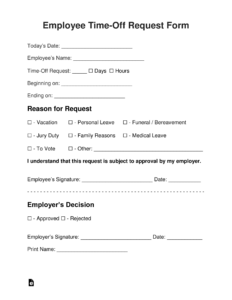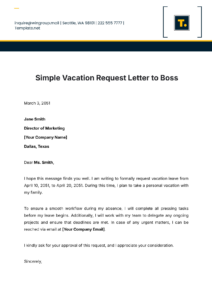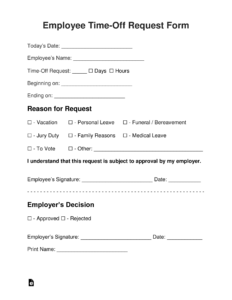Utilizing a structured approach for leave requests offers numerous advantages. It streamlines workflow, reduces the potential for miscommunication or errors, and contributes to a more efficient and transparent approval process. Furthermore, readily accessible, pre-formatted documentation empowers employees to submit requests promptly and accurately, while facilitating effective absence tracking and reporting for management.
This documentation plays a vital role in broader discussions concerning leave management best practices, policy development, and compliance. The following sections will explore these areas in greater detail, offering practical guidance and insights for optimizing absence management procedures.
Key Components of a Leave Request Form
A well-designed leave request form ensures clarity and efficiency in the leave management process. Several essential components contribute to its effectiveness.
1. Employee Information: Accurate employee identification is crucial. Fields for full name, employee ID, department, and job title are typically included.
2. Date of Request: Recording the submission date provides a clear timeframe for processing the request.
3. Leave Type: Specifying the type of leave requested (vacation, sick leave, personal leave, etc.) ensures proper categorization and adherence to relevant policies.
4. Start and End Dates: Precisely defining the leave period, including start and end dates, is essential for accurate scheduling and workload management.
5. Total Days Requested: Calculating the total duration of the requested leave, accounting for weekends and holidays, ensures consistent record-keeping.
6. Reason for Leave (Optional): While not always mandatory, providing a brief explanation for the leave can be helpful for context, particularly for extended absences or specific leave types.
7. Contact Information: Providing contact details, such as a phone number or email address, allows for efficient communication during the employee’s absence if necessary.
8. Supervisor Approval: A designated space for supervisor signature or electronic approval indicates formal authorization of the leave request.
A comprehensive form containing these elements facilitates a streamlined approval process, reduces administrative overhead, and contributes to effective absence management within the organization.
How to Create an Effective Leave Request Form
Developing a standardized leave request form involves careful consideration of various factors to ensure clarity, efficiency, and compliance with organizational policies. The following steps outline best practices for creating a comprehensive form.
1. Define Policy Requirements: Thorough review of existing leave policies is essential to align the form with organizational guidelines concerning different leave types, accrual rates, eligibility criteria, and approval processes.
2. Determine Required Information: Identify essential data points for accurate record-keeping and efficient processing. This typically includes employee identification, dates of requested leave, leave type, and contact information. Consider whether additional details, such as the reason for leave, are necessary or beneficial.
3. Select a Format: Choose a format digital or paper-based that best suits organizational needs and workflows. Digital formats offer advantages in terms of automation, accessibility, and data management.
4. Design the Form: Structure the form logically to ensure ease of use and clarity. Group related fields together and use clear, concise labels. Provide sufficient space for entries and consider incorporating drop-down menus or checkboxes for standardized options.
5. Implement Approval Workflow: Establish a clear approval process, outlining the roles and responsibilities of supervisors and other relevant stakeholders. Incorporate designated spaces for signatures or electronic approvals within the form.
6. Communicate and Train: Clearly communicate the new form and associated procedures to all employees. Provide training on how to complete and submit the form correctly, emphasizing the importance of accurate and timely submissions.
7. Regularly Review and Update: Periodic review of the form’s effectiveness and alignment with evolving organizational policies is crucial for continuous improvement and optimization of leave management processes.
A well-designed form, combined with clear communication and streamlined procedures, contributes significantly to efficient leave management, reducing administrative burden and ensuring compliance.
Standardized leave request documentation provides a crucial framework for managing employee absences effectively. From ensuring accurate record-keeping and streamlined workflows to facilitating clear communication and compliance with organizational policies, a well-designed form contributes significantly to operational efficiency. Key components such as clear identification of the employee, specific dates of leave, categorization of leave type, and designated approval processes are essential elements for a comprehensive and functional document. Furthermore, the creation and implementation of such a system require careful consideration of existing leave policies, efficient design, and clear communication to employees regarding proper usage.
Optimizing absence management processes through structured documentation empowers organizations to enhance productivity, reduce administrative overhead, and foster a transparent and equitable work environment. Moving forward, regular review and adaptation of these processes in response to evolving organizational needs and best practices will remain critical for maintaining efficient and compliant leave management systems. Investing in robust systems and procedures for managing leave requests represents a commitment to both operational excellence and employee well-being.


